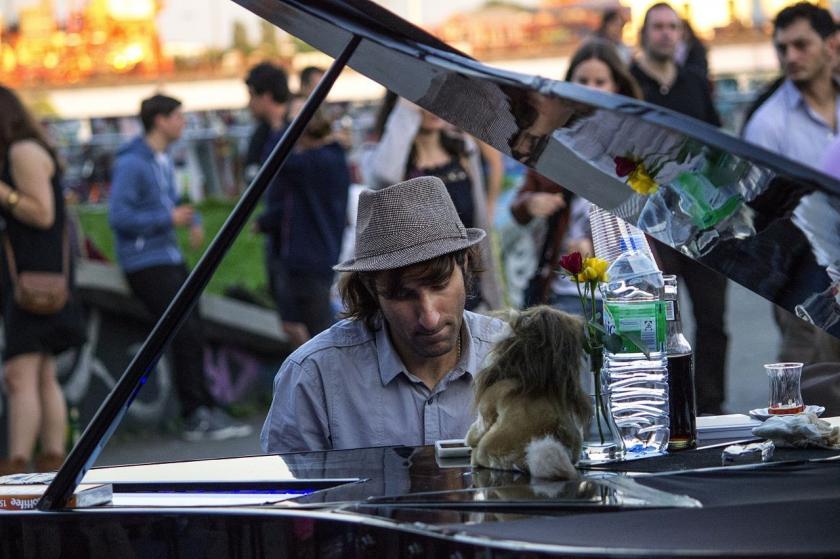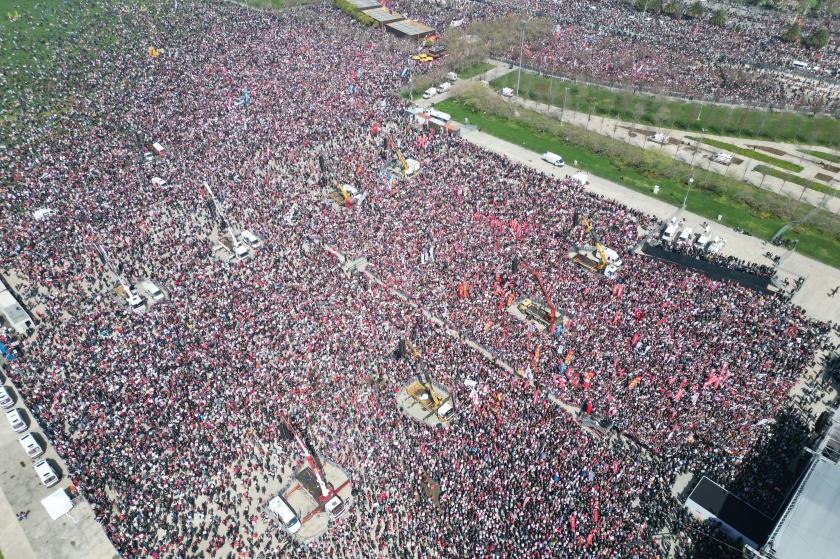How did neo-Nazi organizations in Ukraine manage to get to where they are today?

Yücel Özdemir

Fotoğraf: Stringer/AA
It is known that in Russia a broad campaign has been conducted against various social movements opposing to “Putin’s war,” and that it is prohibited to refer to the war as “occupation.” Most recently, a woman reporter was taken into trial for showing “No to war” poster to the cameras behind the speaker during live broadcasting.
Similar pressures have been on in Germany too.
Criticising NATO but not Russia has been made almost a “discrimination point.”
In Ukraine, it is banned to criticise the role of President Volodomir Zelensky and his government in the war. The parties and organizations upholding the war to stop, Russia to withdraw and Ukraine to remain independent were deemed to be “pro Russia,” and they were banned through a decree on Mar 20.
Amongst those banned included also Opposition Platform, which got the second place in 2019 elections with 13% of votes after Zelensky’s party (Sluha Narodu) “Servant of the People.” Communist Party of Ukraine had also been banned in 2015. Other parties banned by the last decree are as follows: “Left Opposition,” “Union of Left Forces,” “Progressive Socialist Party of Ukraine,” “Socialist Party of Ukraine,” “The Socialists,” “Ours,” “The State,” and “Vladimir Saldo Block.”
BUT FASCIST ORGANIZATIONS ARE FREE
One section of important supporters of Zelensky is observed to be domestic and foreign fascist parties and organizations.
It is known that neo-Nazis from various countries around the world have travelled to Ukraine to fight. Within Ukraine, following the “Maidan Coup” in 2014, fascist party and organizations have become an important power, and they were recognized and supported by NATO, the USA and the EU.
In a report prepared by Roza Luxemburg Foundation, some major fascist movements, currently operating in Ukraine and increasing their power because of the war, were listed as follows:
AZOV/AZAK MOVEMENT
Azov/Azak Movement (Asowskyj Ruch): has the characteristic of being the biggest far right-fascist movement in the country. The organization is comprised of three sections: Military wing is Azov Brigade, political wing is National Party of Army Corps, and paramilitary wing is the National Citizens’ Defence.
Organization is described to have 20 thousand members. It has more than 1500 well trained fighters. Following the 2014 Coup, the military wing of the organization was constituted as part of Ukrainian army. It is explained that there is mainly this force in Mariupol Russia has had under siege. Openly advocating Nazism as its ideology, Azov movement has been organized specifically amongst the fans of Dinamo Kyiv, Metalis Kharkiv and Shakhtar Donetsk soccer teams.
Arsen Awakow, minister of interior after the 2014 coup, has the biggest role in the organization’s becoming part of the army and accumulating power. Awakow, taking part in the government Petro Poroshenko established, was the only name keeping his place in the cabinet after Zelensky was elected. In other words, he always kept his place in the cabinet because of the support neo-Nazis provided after 2014. Established in 2017, paramilitary Azov National Citizens’ Defence, on the other hand, has been terrorising especially immigrants and ethnic population, as the supporting force of the police.
SWOBODA
Swoboda (Liberty): Established in 1991 and becoming a party in 1995, Swoboda had been the most powerful fascist party in Ukraine between 2011 and 2014. It had been represented in the parliament with 37 MPs (member of parliaments). It lost its power once other far right-fascist organizations acted quicklier during the “Maidan coup” occurred in 2014. In 2019 general elections, it had sent five MPs to Rada, National Parliament, and it currently has 15 representatives in local parliaments.
Swoboda embraces itself as the continuation of “Ukrainian Nationalist National Army” established by Stapen Bandera. The leader of the organization, Oleh Tjahnybok had been hosted in many occasions by the representatives of EU countries. Swoboda had provided support to the government founded after 2014. It is also in relations with other racist organizations of Europe.
The military wing of the organization is represented by its youth organization, Sokil. Conducting military training amongst youth, the organization has organized many times, many street attacks against immigrants and anti-fascists.
PRAWYJ SEKTOR
Prawyj Sektor (Right Sector): is entirely a paramilitary organization established through the participation of far rightists from various regions of the country during the Maidan demonstrations in 2014. However, it was not approved as an arm of the formal security forces of the state. It is said that it possesses a large number of heavy arms. The leader of the organization, Dmytro Jarosch resigned from his post after clashing with police in Trans-Carpats region. For this reason, it is stated that it is in crisis. Comprised as a union of various organizations, Right Sector also claims to be the follower of Stepan Bandera.
C14
C14: is known to be a far right, radical fascist, having approximately estimated 350 members in Kyiv and its surroundings, and having organized racist attacks on especially anti-fascists and Romans. Two members of C14 were put on trial on the charge of murdering Oles Busina, an anti-fascist broadcaster. Apart from that, having organized attacks on many anti-fascists, according to the report, this organization is receiving monetary support from the state.
Apart from the above, fascist organizations such as Derschawnyzka Iniziatywa Jaroscha (DIJA), Karpatska Sjtsch, Frajkor, Bratstwo, Tradizija i porjadok, Katechon, Newidomyj Patriot continue to operate in the country legally.
Developments show that fascist movements get stronger and become part of the state as the USA, EU and NATO increase their influence on Ukraine. Having used fascist organizations and individuals against socialism during the years of Cold War, it is understood that the West has used the fascist movements against Russia in order to increase its influence on Ukraine for the last 20 years.
That is why Russian leader Putin has, in every opportunity, mentioned, amongst the reasons for the occupation, that Ukraine would be freed from Nazis. However, it is necessary to underline that this is not a reason that would make the occupation just.
BANDERA, MELNYK AND TODAY
Stepan Bandera, a collaborator of Hitlerite fascism is referred to as “national hero” by the fascist organizations and an important section of the governors of the state today. Born in 1909, Bandera had been convicted with the murder of then the minister of interior of Poland in 1934. However, he was released after the World War II started. Then he colaborated with German fascists. In order to found an independent Ukraine, he established the Organization of Ukrainian Independence (OUN) with Andrij Melnyk. Both commited many massacres.
When the war ended, Bandera and Melnyk fleed to Germany. Due to murders he committed, Bandera was sentenced to death by USSR, and in 1959, he was killed by KGB Agent Bohdan Stashynsky in Munich. His tomb is still in Munich and visited by Ukrainian nationalists.
Melnyk, on the other hand, died in Cologne in 1964, and buried in Luxembourg.
Amongst those frequently visiting Bandera’s tomb in Munich is also included the Ukranian ambassador to Germany, Andrij Melnyk. Born in 1975, there is no information about whether the ambassador Andrij Melnyk is a grandchild of fascist Andrij Melnyk or a relative of his. Despite many references to him in publications, no information is cited about the parents of Ambaasador Andrij Melnyk.
Nevertheless, despite reactions, his visits to Bandera’s tomb every time he travels to Munich indicates a high likelihood that there might be some relation between the two Melnyks.
Being considered as “national hero” specifically in western Ukraine, Bandera was titled with “Hero of Ukraine” by then the President Viktor Yushchenko on January 22, 2010. On the other hand, his hero title had been revoked by the new President Viktor Yanukovych in Mar 2010. Zelensky, elected in 2019, did not consider changing the names of the places named after Bandera.




Follow Evrensel